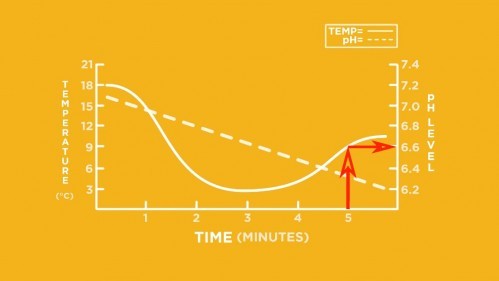Your Week-Before-the-ACT Game Plan (Part 4 of 4: Science)
This is the final installment of our week-before-the-ACT game plan. Let us know how your game plan works on the big test!

The Setup
It’s nice to finish off the ACT with another shorter test. The Science Test, like the preceding Reading Test, will give you 40 minutes to answer 35 items. Those 35 items will be spread over 6 to 7 scenarios.
The Tables Have So Many Rows and Columns
Do you need to be reminded how complicated ACT Science tables can get? ACT is an expert at packing a ton of info into a single table. And the more information they put in a table, the more confusing and intimidating the table is likely to be.
Use one simple principle to read the tables efficiently: the first column almost always tells you WHO the table is about, and the rest of the columns tell you WHAT they are going to tell you about the WHO. Take the table below, for instance. The table is about different months. For each of those months, the table gives you the temperature, the pH, and the dissolved oxygen reading. This principle works no matter how difficult the table becomes.

And The Graphs Have So Many Plots and So Many Axes
Do they have to display so many relationships on a single graph? Along with multiple graphed relationships, you are often given multiple x- and y-axes. Yes, the graphs can get complicated in a hurry. Your ability to locate relevant information and interpret it will be crucial. Follow these two steps to simplify the process:
- Use the key to figure out which graph corresponds with which axis. In the graph below, you see the solid temperature graph corresponds with the axis on the left, and the dashed pH graph corresponds with the axis at the right.
- Be prepared to trace lines to find specific values. Can you find the pH level at the 5-minute mark? Start at the 5-minute mark and draw a line up to the solid pH line. From there, trace right to the pH axis. The pH is about 6.6.

What About the Text-Only Passage?
The Conflicting Viewpoints scenario will be the only scenario comprised of only text. Several viewpoints will be presented. As you read the viewpoints, underline key details from each, making sure to note how they differ. You will be asked to differentiate between the perspectives.
A Game Plan
Read the introductory text of each scenario carefully. The text is used to explain the setting of the research or experiments. Understanding the setting is often critical to interpreting the tables and graphs correctly.
For each table, identify WHO the table is about and WHAT they are going to tell you about the WHOs. For graphs, note the input axis label (horizontal axis) and the output axis label (vertical axis) and check to see if there is a key. You will not likely need to spend any significant time reading the tables and graphs before you get to the questions. Use the questions to tell you where to focus on the tables and graphs.
Many of the more difficult items will require you to synthesize information from several pieces of the scenario. Information found in the text may be key to understanding a table. Data from two graphs may be required to answer a single item. Many times, these difficult items are found in the final few questions of a scenario.
Recent Posts:
Your Week-Before-the-ACT Game Plan (Part 3 of 4: Reading)
Your Week-Before-the-ACT Game Plan (Part 2 of 4: Math)
Your Week-Before-the-ACT Game Plan (Part 1 of 4: English)
Your Week-Before-the-ACT Game Plan (Part 2 of 4: Math)

This week, we’re helping you put the finishing touches on ACT prep before the big test. Sports teams wrap up practices and perform walk-throughs to rehearse the game plan and let their bodies recover. We want to help you wrap up your ACT prep, rehearse your game plan, and ensure your mind is at its peak for this weekend. Yesterday, we reviewed our game plan for the ACT English section. If you missed it you can find it here. Now on to the Math Test…
The Setup
For the Math Test, you’ll be given 60 minutes to work 60 items. Consider this good news because 1) it makes time-keeping super easy, and 2) this is more time per item than you will be given on any other section.
All Those Topics?!?!
The difficulty with preparing for the Math Test is that there are SO MANY concepts that can be tested. On the English Test, you will be tested on grammar, punctuation, and structure, but there are limited variations within each of these topics. On the Reading Test, expect to encounter six different question types at differing levels of difficulty. On the Science Test, you’ll need to be able to evaluate experiments, research, and theories while pulling data from tables and graphs. While algebra may sound innocuous, there are a multitude of algebra concepts. Similarly, geometry and trig can be tested in many ways from many angles. This is where paying attention in class and a quality ACT prep program really pay off.
All Those Words?!?!
To make things even more difficult, ACT feels compelled to make math items wordy—very wordy. Many of the items will come in paragraph form. Save time by realizing the question is almost always at the end of the paragraph. If you are comfortable, start there so you will know what info you need to find. Sometimes, all the info you need will be found in the accompanying picture. The most vital part of the text is usually the numbers and equations. Plucking this info from the text may allow you to avoid reading unnecessary information.
Not All Items are Created Equal
Even though you are given one minute per item, most of them shouldn’t take a full minute to work. On easy problems, don’t second guess yourself to the point of wasting time. A 10-second item should stay a 10-second item. You’re putting time in the bank to use on that crazy, out-of-left-field logic problem you’ll encounter later on the exam.
A Game Plan
After that description, the Math section may sound intimidating, but it doesn’t have to be overwhelming. Create a game plan that caters to your strengths and style. My own game plan sounds something like this:
Sixty minutes is plenty of time. I’ll need to keep a good pace and save time on easier items so I can spend more time on more difficult items that tend to show up at the end of the test. I am confident in my Algebra skills: solving equations, solving inequalities, evaluating graphs, and so on. My geometry skills should be up to the challenge, too. I know I’ll need to work with angles within polygons and circles. I expect at least a right triangle or two. I’ve brushed up on my Probability and Stats. (ACT said they would be testing this a little more often.) To ensure I’m ready to make a top score, I’ve reviewed my trig, too. Make sure to finish the test! Leaving items blank just leaves points on the table.
Now it’s your turn! Print a Math Test and walk your way through it. (You can find a recently released exam in ACT’s Preparing-for-the-ACT Guide.) Recite your own game plan for the Math section. Take your time to scan the items—not necessarily working them—to see how well your game plan works. You’ll get even more value if you’re willing to put a check mark by each item you’re pretty confident you can work. At the end, count up your check marks and score your test by using the scoring chart at the end of the manual. Having a good feel for where you will end up will help you perform to your ability this weekend!



